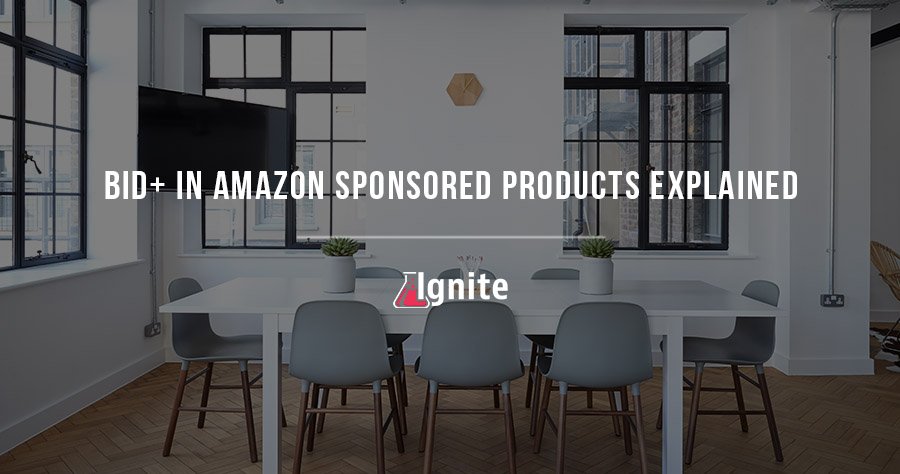Bid+ in Amazon Sponsored Products Explained

Amazon Sponsored Products has many moving parts. Understanding its nuances and intricacies takes times and practice. One of the more difficult aspects of running successful Sponsored Products campaigns is getting your bid spend right in order to win the auction. We frequently get asked by sellers what the right bid spend should be. But there isn’t a magic number because bids change constantly and are unique to each product sold. Amazon’s Bid+ feature give sellers an extra boost to give them a winning advantage. But is Bid+ really the best tactic for winning the ad auction?
Amazon Bid+ in Sponsored Products Explained
Amazon Bid+ will automatically boost ad group or keyword bids on a manually targeted campaign up to 50% when enabled. Amazon will often display ads enabled with Bid+ in the top row of the search results page—but not always; it’s believed that these ads are placed in the center because they will receive a higher click-through and conversion rate. Be aware that your average cost per click (CPC) will increase by using Bid+. But your daily budget constraint won’t increase.
Within an Amazon Sponsored Products campaign, a seller can set their desired CPC on an ad group or keyword level. If you set your keyword or ad group bid to $1, that means you’re willing to pay $1 for each click on your ad. Ads are displayed based on a variety of parameters:
- Daily budget
- Keyword relevance
- Ad rank
- Ad relevance
- Buy box eligibility
So if you meet all of the necessary parameters and have the right bid, you should win the ad auction. But it’s not always that easy. Competition is fierce and many sellers get beaten at the auction by a few cents or less. So what happens? Sellers start incrementally raising their bids on keywords to influence performance. Amazon saw that sellers were doing this and decided to create a tool to help sellers who were willing to spend an added cost to win. The result of this need became Bid+.
Is Bid+ the Best Method for Winning the Ad Auction?
No. But we say this for a couple of reasons. First, because Bid+ isn’t the most tactical way to win clicks and sales. Using Bid+ is like throwing money at a problem and hoping it goes away without really solving the problem. The problem being: optimizing bid spend and ACoS percentage. Fortunately, there is a Performance by Placement report that allows sellers to compare the performance of individual campaigns using Bid+. Sellers can use this report to view the performance of their campaigns when Bid+ is on or off. This report measures impressions, clicks, CPC, spend, and sales of each Bid+ campaign. Sellers can then determine the impact Bid+ has had on their sales in order to identify which campaigns are benefiting from the feature. These reports weren’t always available to sellers who used Bid+. Amazon didn’t use to give sellers any detailed reports to show whether or not Bid+ had any effect on their campaigns. Amazon still recommends that sellers “measure the impact of Bid+ by comparing performance with the feature off and then on.” That’s not a very scientific response for one of the largest e-commerce and tech companies on the planet. Basically, Amazon is telling sellers to turn it on, spend more money, turn it off, spend less money, and then see if your keyword or ad group did better or worse with Bid+. Amazon also states it does not guarantee the conversion rate or ACoS will improve with Bid+ on. But ACoS will more than likely increase because you are actually bidding more.
Ad Spend Strategies: Aggressive vs Conservative
Second, there are different strategies when it comes to running Sponsored Products ads that will give you great data on how much you need to be spending. When starting—and even optimizing—an ad group or keyword bid, you can either go aggressive or conservative with your spending. The advantage of the aggressive approach is that you’ll get more data quicker. Once you’ve gathered plenty of impressions, clicks, and sales, you’ll be ready to optimize. Your optimization approach will be to lower your bids to get to the sweet spot. High bids will give you detailed data to move faster toward your optimal bid spend.
The conservative method means you will be slowly increasing your bid spend until you get to your optimal ACoS percentage. Reaching a high number of impressions, clicks and sales will take much longer compared to the aggressive approach. You’ll slowly gather data about your ads but you’ll also spend much less upfront. Your bid optimization will be to increase rather than decrease to find the sweet spot.
Of the two methods, we recommend the aggressive approach. Why? Because in order to get to your ACoS and bid sweet spot, you’ll have to get a significant amount of impressions, clicks, and sales to get statistically significant data. You’re better off spending more upfront—and saving time—to get to a statistically significant level of data. The conservative approach will get you there eventually but it will take much more time with a comparable amount of ad spend.
Either spending strategy will give you the necessary data you need to see which keywords, ad groups, and CPC are winning your impressions, clicks and sales. That’s much more analytical and practical than Amazon’s Bid+ strategy.
Bid+ Alternative
If sifting through data and running tests sounds worse than going to the dentist, then you might be thinking Bid+ is the easiest way to win the ad auction. But there’s a better way to run efficient Amazon PPC ads that can give you a clear ROI. It’s called Ignite.
Ignite is Seller Labs’s newest Sponsored Products software application. And it can do a lot of cool things. For the sake of brevity, I’ll just focus on ACoS and ad spend optimization. Whereas Bid+ lets sellers throw an extra lump of money on their ads in the hopes of winning, Ignite tells sellers how much they need to increase or decrease bid spending in order to win.
Example 1: Change keyword match type and decrease bid
In this example, we see that Ignite is suggesting we move the keyword “apple slicer” from a broad keyword match type to an exact match and reduce our bid by 50 cents. Ignite gives you its reasoning based on the number of clicks, CPC and sales the ad has received. Ignite is 95% confident that changing the ad’s keyword match type and spend will result in more clicks at a lower cost.
Example 2: Decrease bid only
In this example, Ignite is suggesting we decrease our bid by 24 cents for the keyword “apple slicer” based on our target ACoS of 25%. Ignite is 80% confident this suggestion will achieve our goal. The reason behind this suggestion is that the ad has received 155 clicks in 14 days with a conversion rate of 36.13%. The ACoS was 56.7% during this period. So Ignite has done the math to help you reach your goal. You can either accept, delay or reject the suggestion.
Ignite is a much more analytical approach to ad spend optimization compared to Bid+, it will also teach you and tell you why an ad needs to change.
Final Thoughts
Don’t you think it’s about time to start sophisticating your Amazon Sponsored Products ads? However easy and effortless Bid+ may seem, it’s not as analytical and it’s much more difficult to prove ROI. Ignite, coupled with an aggressive ad spend strategy, can help you decide where you need to be investing your advertising dollars.
Try Ignite Free for 30 Days

Maria is an SEO Content Specialist at Seller Labs. Once captured by digital and content marketing in her student days, she keeps living and breathing it ever since.






